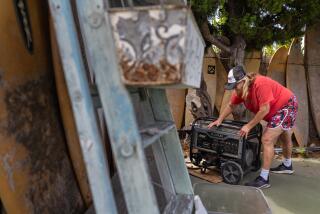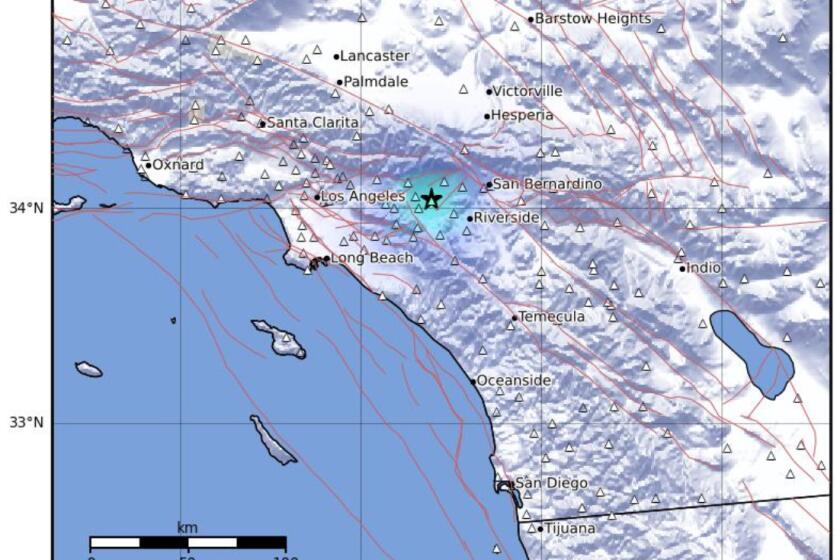After the Quake : South Pasadena: Bricks Fall and Bad Dreams Linger
The Rev. John C. Lathrop stood in the 75-foot bell tower of St. James Episcopal Church and examined the damage. Jagged fissures ran across the walls, bricks bulged out of their settings and hefty pieces of cornice appeared ready to fall from the tower’s arched openings.
“This whole corner here is getting ready to fall,” said Lathrop, the church’s assistant rector, pointing to an expanse of wall where the mortar had been shaken out of the spaces between the bricks. “It’s incredibly dangerous.”
Good point, someone suggested. How did Lathrop feel about standing there, barely 30 hours after Sunday’s aftershock, in one of South Pasadena’s most precarious structures, with terra firma at the opposite end of a 75-foot climb up a metal ladder and a spiral staircase?
‘OK to Visit’
Lathrop flashed a wry grin. “ Menza , menza ,” he said, wiggling his hands palm down in the age-old gesture for “so-so.” “I’m not ready to have lunch up here, but it’s OK to visit.”
The 80-year-old church is one of 10 buildings in South Pasadena with major structural damage from last week’s earthquake, which also demolished about 100 chimneys in the city, disrupted businesses and sent dogs and cats howling through the streets, according to public safety officials.
By Tuesday, inspectors from the Fire Department and the Building and Safety Department had responded to as many as 400 complaints of potentially dangerous conditions, said Fire Capt. Roger Houston.
“Everybody wants their building checked now,” said Houston, whose department by Tuesday had a backlog of more than 150 inspection requests.
But the most serious conditions were in buildings built before 1933, when municipalities such as South Pasadena began adopting building codes that required walls to resist sideways as well as up-and-down stresses. Cracks in walls were the order of the day in most South Pasadena structures, officials said, but older buildings, particularly those made of unreinforced masonry, were particularly vulnerable to structural damage.
Engineers to Decide
Engineers are still trying to determine which of the damaged buildings may have to be demolished. “In the final analysis, it depends on what the structural engineers say,” said Police Chief William Reese.
The earthquake was not generally good for business in South Pasadena. Among the stores closed were five in a strip on Huntington Drive and Fremont Avenue, including a laundry and dry cleaners and an insurance office, and two mainstays of downtown South Pasadena, Weaver’s Fix It Store and Gus’s Bar-B-Q, next to each other on Fair Oaks Avenue.
Some merchants grumbled that inspectors were being alarmist in sealing buildings. “The firemen get excited when they see some cracks in the wall,” said Jim Moore, owner of Gigantic Cleaners, two doors down from Weaver’s. “Some of those cracks were from maybe 20 or 30 years ago.” Moore worried that the city might order Weaver’s and Gus’s demolished, forcing the landlord to tear down his own store.
“I’d be out of business,” Moore said. “I’m 65 and there’s nowhere else to start up.”
Store ‘Like Mausoleum’
Jerry Ward, owner of the Laundry Store at Huntington Drive and Fremont Avenue, expressed similar sentiments. “This is one of those buildings (city officials) hate,” he said, waiting behind yellow police tape for customers to pick up their dry cleaning.
Arms folded, Ward leaned dejectedly against a table in the customerless store. “Right now, it’s like working in a mausoleum,” he said.
But Ward, whose ceiling and front wall appeared to be separating after Sunday’s early morning aftershock, had taken some precautions while he waited. “I’ve got the back door open and I’m wearing my running shoes,” he said.
For homeowners, the greatest problem from the quake was damaged chimneys.
Sue Taylor said her chimney, a massive structure of river stones and mortar, gave way Thursday morning, sending an avalanche of fragments across the front lawn and onto Oak Street. “My daughter was in here playing the piano,” she said. “There was a tremendous shuddering noise from the chimney. Fortunately, nobody was walking past at the time.”
The living room was covered with soot and debris, Taylor said, and her chimney is still jammed with rocks. “My daughter (8-year-old Emma) has been having a lot of trouble sleeping,” she added. “Every little noise wakes her up. She was getting more confident until the aftershock on Sunday morning.”
The congregation at St. James is determined to save the structure, which may cost $700,000, Lathrop said. The first step will be to construct exterior reinforcements to prevent further damage from aftershocks.
“At least half of this occurred since Sunday morning,” Lathrop said, pointing at plaster and mortar that had fallen from the frame of a rose window high on the church’s east wall.
The church, which has been designated as a California historic landmark and is listed on the Federal Register of historic buildings, conducted services last Sunday in a smaller, adjoining building.
In the meantime, priests like Lathrop are working to repair a less visible kind of damage.
“We’ve done a lot of counseling--people whose sleep has been disturbed,” Lathrop said. “My wife dreamed the other day that the world was coming to an end. She woke up afraid, and she said she didn’t know it wasn’t true for a couple of minutes. I told her, ‘There are probably a lot of people out there having the same dream. You’re not alone.’ ”
More to Read
Sign up for Essential California
The most important California stories and recommendations in your inbox every morning.
You may occasionally receive promotional content from the Los Angeles Times.










